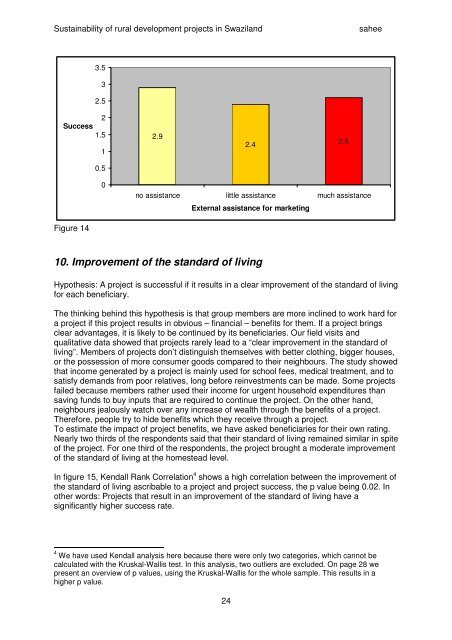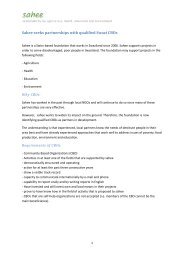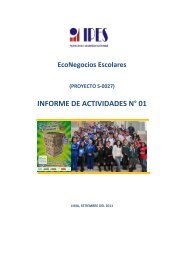Sustainability of rural development projects in ... - sahee foundation
Sustainability of rural development projects in ... - sahee foundation
Sustainability of rural development projects in ... - sahee foundation
Create successful ePaper yourself
Turn your PDF publications into a flip-book with our unique Google optimized e-Paper software.
<strong>Susta<strong>in</strong>ability</strong> <strong>of</strong> <strong>rural</strong> <strong>development</strong> <strong>projects</strong> <strong>in</strong> Swaziland<br />
<strong>sahee</strong><br />
3.5<br />
3<br />
2.5<br />
2<br />
Success<br />
1.5<br />
1<br />
2.9<br />
2.4<br />
2.6<br />
0.5<br />
0<br />
no assistance little assistance much assistance<br />
External assistance for market<strong>in</strong>g<br />
Figure 14<br />
10. Improvement <strong>of</strong> the standard <strong>of</strong> liv<strong>in</strong>g<br />
Hypothesis: A project is successful if it results <strong>in</strong> a clear improvement <strong>of</strong> the standard <strong>of</strong> liv<strong>in</strong>g<br />
for each beneficiary.<br />
The th<strong>in</strong>k<strong>in</strong>g beh<strong>in</strong>d this hypothesis is that group members are more <strong>in</strong>cl<strong>in</strong>ed to work hard for<br />
a project if this project results <strong>in</strong> obvious – f<strong>in</strong>ancial – benefits for them. If a project br<strong>in</strong>gs<br />
clear advantages, it is likely to be cont<strong>in</strong>ued by its beneficiaries. Our field visits and<br />
qualitative data showed that <strong>projects</strong> rarely lead to a “clear improvement <strong>in</strong> the standard <strong>of</strong><br />
liv<strong>in</strong>g”. Members <strong>of</strong> <strong>projects</strong> don’t dist<strong>in</strong>guish themselves with better cloth<strong>in</strong>g, bigger houses,<br />
or the possession <strong>of</strong> more consumer goods compared to their neighbours. The study showed<br />
that <strong>in</strong>come generated by a project is ma<strong>in</strong>ly used for school fees, medical treatment, and to<br />
satisfy demands from poor relatives, long before re<strong>in</strong>vestments can be made. Some <strong>projects</strong><br />
failed because members rather used their <strong>in</strong>come for urgent household expenditures than<br />
sav<strong>in</strong>g funds to buy <strong>in</strong>puts that are required to cont<strong>in</strong>ue the project. On the other hand,<br />
neighbours jealously watch over any <strong>in</strong>crease <strong>of</strong> wealth through the benefits <strong>of</strong> a project.<br />
Therefore, people try to hide benefits which they receive through a project.<br />
To estimate the impact <strong>of</strong> project benefits, we have asked beneficiaries for their own rat<strong>in</strong>g.<br />
Nearly two thirds <strong>of</strong> the respondents said that their standard <strong>of</strong> liv<strong>in</strong>g rema<strong>in</strong>ed similar <strong>in</strong> spite<br />
<strong>of</strong> the project. For one third <strong>of</strong> the respondents, the project brought a moderate improvement<br />
<strong>of</strong> the standard <strong>of</strong> liv<strong>in</strong>g at the homestead level.<br />
In figure 15, Kendall Rank Correlation 4 shows a high correlation between the improvement <strong>of</strong><br />
the standard <strong>of</strong> liv<strong>in</strong>g ascribable to a project and project success, the p value be<strong>in</strong>g 0.02. In<br />
other words: Projects that result <strong>in</strong> an improvement <strong>of</strong> the standard <strong>of</strong> liv<strong>in</strong>g have a<br />
significantly higher success rate.<br />
4 We have used Kendall analysis here because there were only two categories, which cannot be<br />
calculated with the Kruskal-Wallis test. In this analysis, two outliers are excluded. On page 28 we<br />
present an overview <strong>of</strong> p values, us<strong>in</strong>g the Kruskal-Wallis for the whole sample. This results <strong>in</strong> a<br />
higher p value.<br />
24





